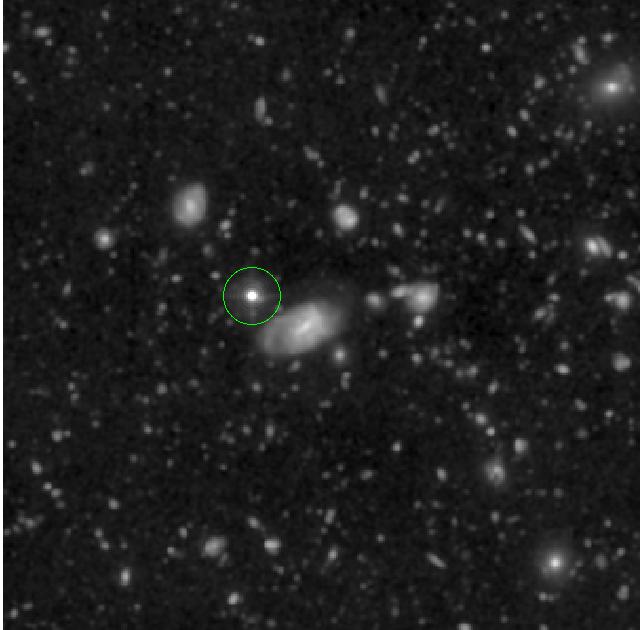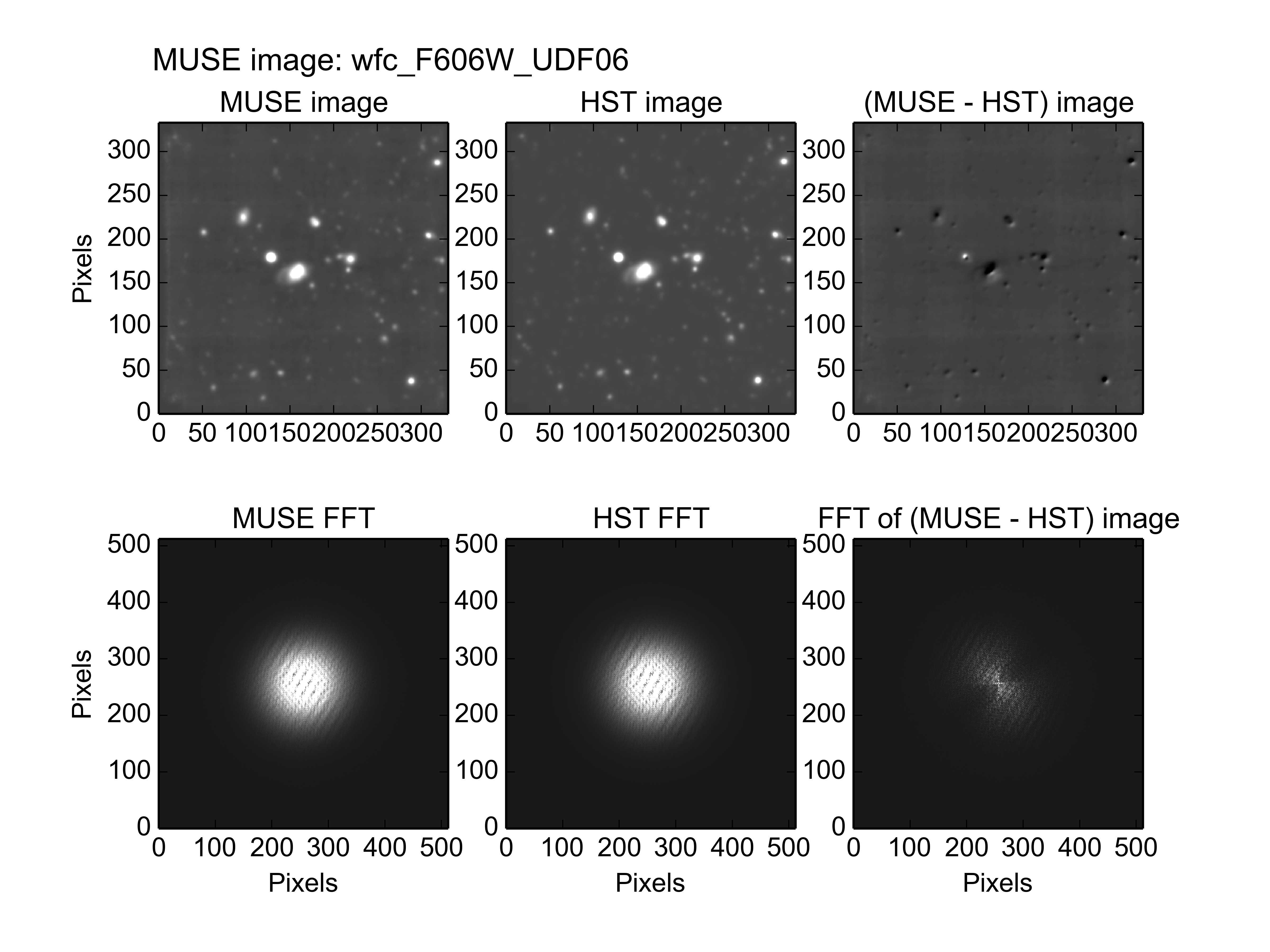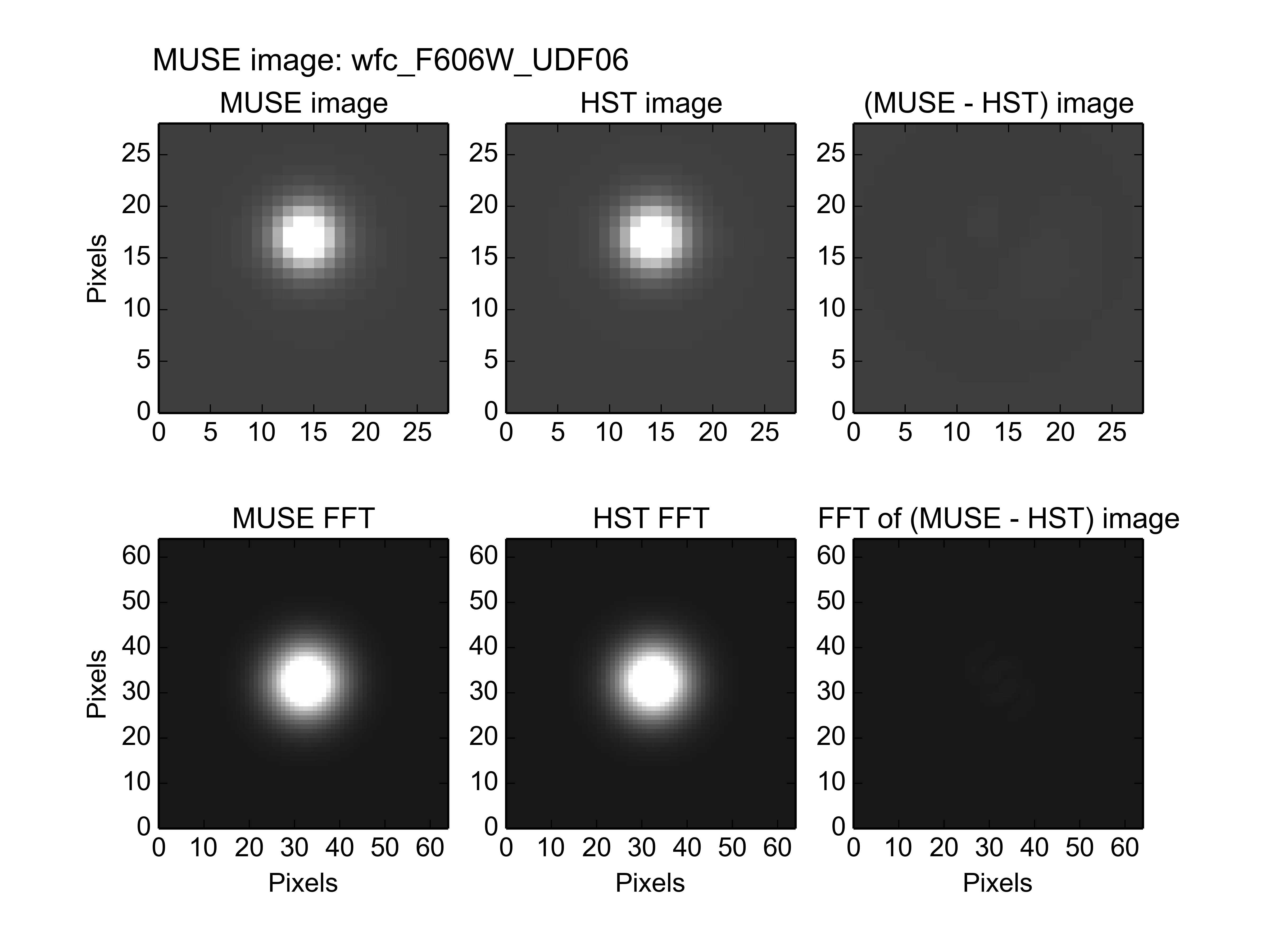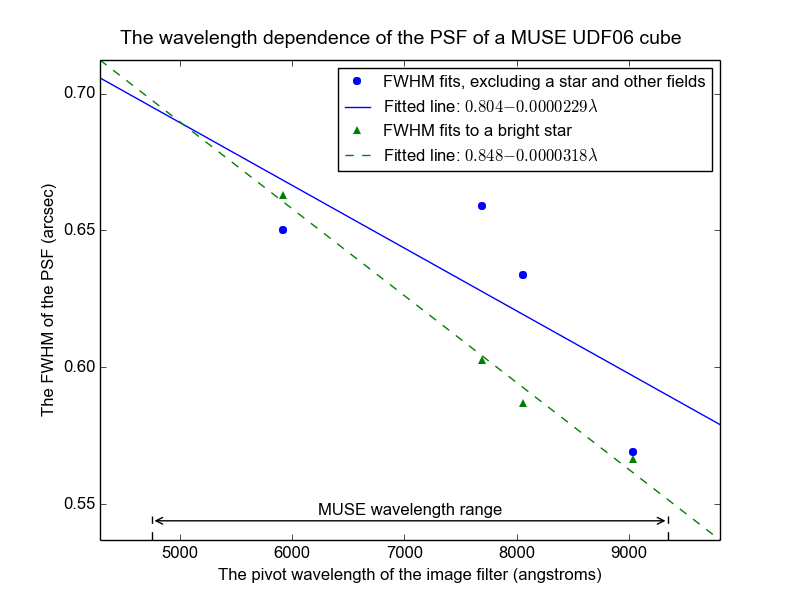The photometry of MUSE field UDF06
Muse field UDF06 is a 1x1 arc-minute field centered at Right Ascension 03:32:42, and declination -27:47:55, within the Hubble UDF. The HST image of this region, seen through the F606W filter and resampled onto the pixel grid of the MUSE images of UDF06, is shown below.

This field contains a bright star which should be excluded from the fit to obtain a good fit for all other sources between the MUSE and HST images, as described in the pitfalls section. The output of the following command, including the plot shown below it, show the poor fit that is obtained if the star is not excluded from the fit:
% fit_photometry hst_F606W_for_UDF06.fits UDF06/wfc_F606W_UDF06.fits --fix_beta=2.8 --hardcopy jpeg
# MUSE observation ID Method Flux FWHM beta Flux x-offset y-offset
# scale (") offset (") (")
#--------------------------------- ------ ------ ------ ------ -------- -------- --------
wfc_F606W_UDF06 image 1.0230 0.6410 2.8000 0.05630 -0.16250 0.21167

A very poor fit was obtained on this image, as seen by the strong hints of the original sources in the residual image. The reason for the poor fit is that the bright star is much brighter than anything else in the original images, and this star moved significantly between the HST and MUSE observations. To minimize the residuals, which were dominated by the star, the least-squares fit shifted the images to align the star, and this misaligned the rest of the sources in the image. Evidence of this misalignment can be seen in the asymmetric nature of the residuals of all of the sources except the star.
If the star is excluded from the fit, as recommended in the
pitfalls section, by passing
exclude_udf_stars.reg
region file to the fit_photometry script, then
the results are as follows:
% fit_photometry ~/muse/images/UDF06/hst_F606W_for_UDF06.fits ~/muse/images/UDF06/wfc_F606W_UDF06.fits --regions=regions/exclude_udf_stars.reg --fix_beta=2.8 --hardcopy jpeg
# MUSE observation ID Method Flux FWHM beta Flux x-offset y-offset
# scale (") offset (") (")
#--------------------------------- ------ ------ ------ ------ -------- -------- --------
wfc_F606W_UDF06 image 0.9340 0.6681 2.8000 0.06155 -0.00153 0.00035

Excluding the star resulted in a much better fit, in which the much smaller range of values in the residual image now allows one to see the instrumental background of the MUSE image. However there are still a couple of small, obviously over-subtracted sources near the right edge of the residual image. This is because the UDF06 image was actually extracted from a cube that contained a mosaic of all of the MUSE UDF fields, and the UDF02, UDF03, UDF05, UDF08 and UDF09 fields overlap the upper, right and lower edges of UDF06. To resolve this the following region file was created that excludes not only the bright star, but also the rectangular regions of the overlapping fields. The contents of the region file look as follows:
fk5
-box(3:32:41.610,-27:46:30.78,67.2",67.4",41.9952) # Exclude UDF02
-box(3:32:44.733,-27:47:11.58,66.6",66.2",41.9891) # Exclude UDF03
-box(3:32:38.559,-27:47:13.45,67.2",67",42.0011) # Exclude UDF05
box(3:32:41.897,-27:47:55.48,67",67",41.9946) # Include UDF06
-box(3:32:35.462,-27:47:58.25,66.6",66.6",42.0071) # Exclude UDF08
-box(3:32:38.827,-27:48:35.64,67",66.8",42.0006) # Exclude UDF09
-circle(53.176896, -27.799861, 3.0") # Exclude star
When this is passed to the --regions argument, the fit changes as follows:
% fit_photometry hst_F606W_for_UDF06.fits wfc_F606W_UDF06.fits --regions=udf06_extract.reg --fix_beta=2.8 --hardcopy jpeg
# MUSE observation ID Method Flux FWHM beta Flux x-offset y-offset
# scale (") offset (") (")
#--------------------------------- ------ ------ ------ ------ -------- -------- --------
wfc_F606W_UDF06 image 0.9398 0.6503 2.8000 0.05477 -0.00385 0.00282

This appears to be a slightly better fit for the sources within the extracted part of UDF06. There is still something left of the large bright source near the center of the image, but this is probably due to the clear trough in the instrumental background, left over from the original MUSE image. This is probably a less sensitive part of the image, with a slightly different flux scale than the rest of the image.
Another estimate of the PSF can be obtained by restricting the fitted area of the image to a small region around the star, as follows:
% fit_photometry hst_F606W_for_UDF06.fits wfc_F606W_UDF06.fits --regions=udf06_star.reg --fix_beta=2.8 --hardcopy jpeg
# MUSE observation ID Method Flux FWHM beta Flux x-offset y-offset
# scale (") offset (") (")
#--------------------------------- ------ ------ ------ ------ -------- -------- --------
wfc_F606W_UDF06 image 1.1027 0.6629 2.8000 0.04426 -0.17819 0.23157

The FWHM of the PSF fitted to the star similar to the value fitted to the image without the star. The flux scale-factor is about 17% higher, but that is expected, for the reasons described in the pitfalls section. The fitted pointing error is very different, as expected for a star that has moved. The vector difference between the pointing errors fitted to the star and the image, is 0.29 arcsec. Given that about 11 years elapsed between the HST and MUSE observations of the UDF, this corresponds to a proper motion of about 26.5 mas/year. This is similar to the value of 25.16±0.45 that Pirkal et al (2005) reported for this star (UDF 2150) in [1].
FWHM versus wavelength
The examples of the previous section operated on images that had the spectral response curve of the HST F606W filter. If similar fits are also performed to MUSE UDF06 images that have the spectral response curves of other HST filters, then the variation of the fitted FWHM of the PSF can be obtained versus wavelength. In the following diagram, the best-fit values of the PSF FWHM are plotted versus the pivot wavelength of these filters. The results of 2 different sets of fits are plotted. The first fit was to everything in the UDF06 images except for the bright star, which was excluded with a region file. The second fit was limited to a region of 3 arcseconds radius, centered on the star.

It is not clear why the results for the F775W and F814W filters are so discrepant between the fits to the image without the star, and the fits to the stellar images. If a new fit is performed to the image with the star removed, but this time with the FWHM fixed to the value fitted to the star, then the resulting residuals are not as good, so it appears that the average FWHM values in the F775W and F814W images really don’t behave as expected. One clue to the reason is that the source residuals show some evidence of a position mismatch, but this shift seems to have a different sign on the left and right sides of the image. This suggests a problem in the position registration of the stacked exposures that contributed to the originating MUSE mosaic. Hopefully when individual cubes are available for each field, this will be resolved.
Footnotes